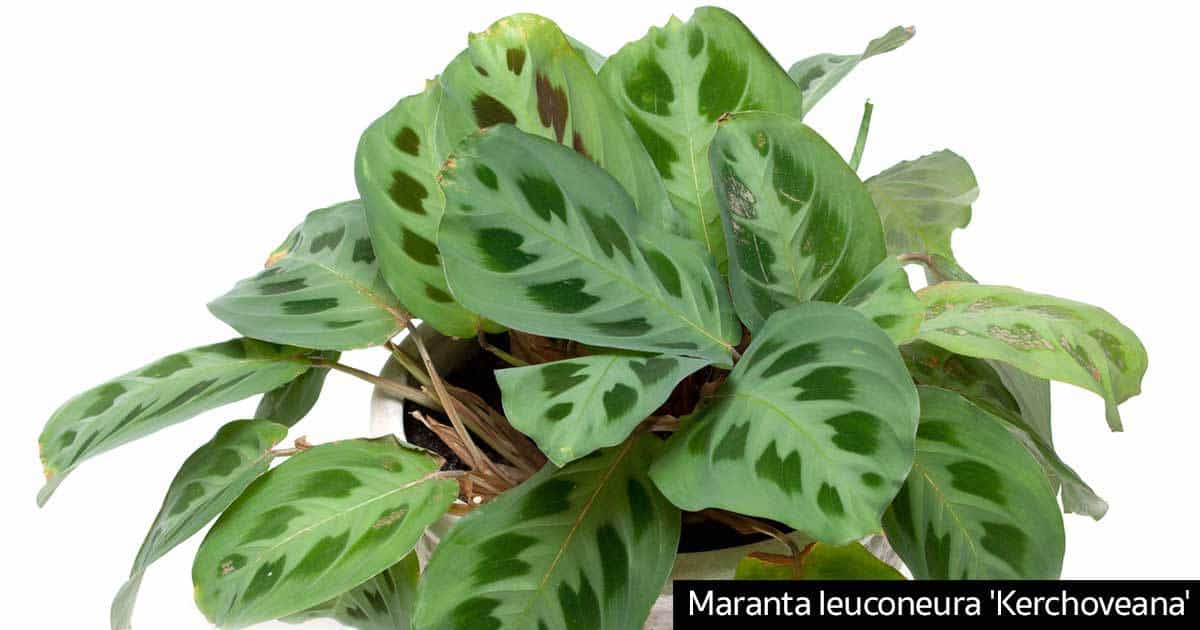Your cart is currently empty!
Gardening for Birds: Planting for White-Breasted Nuthatches
Learn about the unique characteristics of white-breasted nuthatches, their diet, and how to attract them to your garden with native trees.
Your cart is currently empty!
Maranta leuconeura, commonly referred to as the “Prayer Plant,” exhibits a unique leaf folding mechanism that sets it apart. At night, its leaves fold inward, resembling praying hands, hence the name “Prayer Plant.” Additionally, some varieties bear chocolate brown markings on their leaves, leading to the moniker “Rabbit Track Plant.”

Maranta leuconeura ‘Kerchoveana’ is undoubtedly the most frequently encountered species within the Maranta genus and its related cousin, the Calathea plant. Its light green leaves are somewhat rounded with inconspicuous veining.
Distinctive dark splotches are present on either side of the primary rib. Initially, these splotches appear dark brown, but with age, they transform into a deep green. Notably, the deep coloration fades as the leaf matures.
One peculiar characteristic of the leaf construction is that the contrasting colours are not discernible from the underside of the leaf, nor is the vein arrangement visible. The underside of the leaves is a silvery green with a close-lined vein system, resulting in a complete visual distinction between the two sides of the leaf.
The short section connecting the leaf and the stem exhibits a deeper shade of green. This region serves as the pivot point for the leaf’s movement. During the day, it expands, allowing the leaf to spread, while at night, it contracts, folding the leaf vertically.
Some time ago, I acquired a small plant of what was listed as Maranta tricolour. Despite producing only one leaf in a year, it exhibits three distinct colours: green, rose, and white. While its shape is considerably narrower compared to M. leuconeura, the leaf retains the characteristic sharp point and hinged attachment to the stem and leaf.
Maranta discolour, a plant of approximately one foot in height, exhibits growth patterns similar to its counterparts. Unlike other varieties, its leaves lack the distinctive, sharply pointed tip and instead possess a long and narrow shape.
Upon reaching maturity, the leaves of Maranta discolour measure six to seven inches in length. They are characterized by a deep green colour with a pronounced sheen on their upper surface and a deep purple underside. Notably, these leaves are thicker than those of other varieties.
In contrast to other Maranta species, Maranta discolour does not alter the general direction of its leaves during the night. Instead, they may droop slightly but fold lengthwise until the outer edges almost touch. While not as visually striking due to the darker coloration, the rich contrast between the upper and lower surfaces contributes to the overall dignity of the group.
Marantas prefer shaded locations. A light north-facing window is suitable for indoor use during the winter months. They can be moved outdoors during the summer in a cool and shaded area.
Marantas rest at irregular intervals, and their desire to rest is indicated by the browning of the leaf tips.
Occasionally, marantas may go dormant, with their roots drying up and appearing almost lifeless. This was the stage at which I discarded my first plant, harbouring thoughts of failure.
However, if the pot is left almost dry, new growth will eventually emerge spontaneously.
The specific location where marantas are stored does not appear to be the crucial factor. I have stored pots in both warm and dry closets, as well as in unheated locations. The most important factor is to ensure that the pots are not exposed to freezing temperatures or remain excessively dry.
Eventually, new pink shoots will emerge. Some marantas rest once a year, while others may remain vigorous for two or three years.
If young leaves turn brown, it may indicate that the marantas are receiving too much direct sunlight. A humid and hot room with low humidity can cause portions of houseplant leaves to turn brown.
I utilize a loose soil mixture composed of equal parts sand, peat moss, shredded cow manure, and well-draining loam or leaf mold. This mixture is suitable for African Violets.
The soil should be maintained at a consistently moist level, except during periods of rest. The plants receive biweekly liquid fertilizer treatments, which I would not undertake alone. However, since they are placed on a window sill alongside African Violets, they benefit from the same treatment, and their growth has been evident.
The ‘Kerchoveana’ variety, while commonly grown, is less resilient compared to plants such as sansevierias, philodendrons, pothos, and others frequently grouped and grown in indoor planters.
Nevertheless, it will adapt reasonably well to this planting arrangement. If the roots are not constricted, the soil is rich and loose, and the air is humid, the maranta will thrive and become an exceptional plant of interest for this setting. Occasionally, marantas produce common white flowers.
Learn about the unique characteristics of white-breasted nuthatches, their diet, and how to attract them to your garden with native trees.
A south facing window is an excellent place to keep houseplants, as long as you pick the right plants and protect them from extreme sun.
Discover the vibrant beauty of Canna Lily flowers with easy care tips for this stunning perennial plant in your garden.
I finally got my sweet pepper collection planted: Early Calwonder; Pimento; Sweet Cubanelle ; Hungarian Yellow Sweet Banana.
Basic orchid care attempts to recreate the habitat in which a certain variety of orchid developed. We discuss how to care for orchids.
Outdoor orchids, hardy orchids that grow well in a shade garden, are perfect for gardeners looking for a challenging plant.
GardeningCalendar.ca gets some funding from advertisers. If you click on links and advertisements at no cost to you, the site may receive a small commission that helps fund its operation.
© 2025 J&S Calendars Ltd.
Leave a Reply